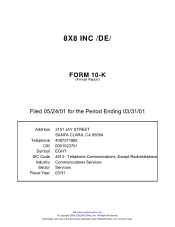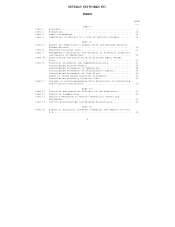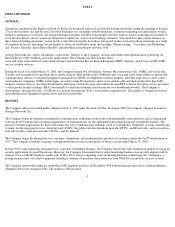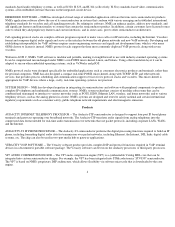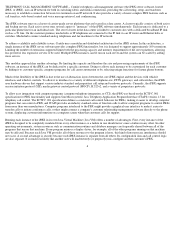8x8 2001 Annual Report Download - page 8
Download and view the complete annual report
Please find page 8 of the 2001 8x8 annual report below. You can navigate through the pages in the report by either clicking on the pages listed below, or by using the keyword search tool below to find specific information within the annual report.standards-based audio telephony systems, as well as H.320, H.323, and H.324 (collectively, H.32x) standards-based video communication
systems, all in embedded software that runs on the integrated circuit device.
EMBEDDED SOFTWARE -- NME has developed a broad range of embedded application software that runs on its semiconductor products.
NME's application software allows the use of its semiconductors in systems that conform with various emerging and established international
telephony standards for vocoders and call signaling protocols. By refining its software, NME can enhance quality, address new standards, and
add significant features and functionality to systems that contain the semiconductor product. In addition, certain customers have licensed source
code to which they add proprietary features and custom interfaces, and in some cases, port to other semiconductor architectures.
Call signaling protocol stacks are complex software programs required to make voice calls over IP networks, including the Internet. Vocoders
format and compress digital audio signals and serve as the interface between the old phone networks and new VoIP networks. Developing and
establishing interoperability for VoIP software requires major engineering resources and significant development time, which is why many
OEMs choose to license it instead. NME's protocol stacks support the three most commonly deployed VoIP protocols, along with seven
vocoders.
Written in ANSI C, NME's VoIP software is modular and portable, making it straightforward to use with industry-standard operating systems.
It can be compiled and run unchanged under NME's own POSIX micro-kernel, Linux, and Solaris. Using a thin translation layer it can be
adapted to run on other embedded operating systems, such as VxWorks and pSOS.
NME's protocol stacks were designed specifically for embedded applications such as consumer electronics products and terminals, rather than
for personal computers. NME has also designed a compact real-time POSIX micro-kernel, along with TCP/IP, RTP, and other network
services, that provides process scheduling and communication support services for its protocol stacks and vocoders. This micro-kernel is
appropriate for VoIP devices where a large, costly, real-time operating system is not practical.
SYSTEM DESIGN -- NME has developed expertise in integrating its semiconductors and software with peripheral components to produce
complete IP telephony and multimedia communication systems. NME's system technology consists of modular subsystems that can be
combined and rearranged to interface to various networks (such as POTS, ISDN, Ethernet LAN, wireless, and home networks) and to various
telephony devices, such as the analog phones in a home. NME's systems are designed and tested to satisfy national and certain international
regulatory requirements such as consumer safety, public telephone network requirements and electromagnetic emissions.
Products
AUDACITY INTERNET TELEPHONY PROCESSOR -- The Audacity-ITP semiconductor is designed to support four-port IP based phone
terminals and gateways operating over broadband networks. The Audacity-ITP translates audio signals from analog telephones into the
compressed data format needed for real-time audio transmission over networks that use packet protocols, including corporate LANs, WANs,
and the Internet.
AUDACITY-T2 IP PHONE PROCESSOR -- The Audacity-
T2 semiconductor performs the digital processing functions required to build an IP
phone, including formatting digital audio data for transmission over packet networks, including Ethernet, the Internet, DSL links, digital cable
systems, etc. The chip can also be used in two-port media hub or gateway applications.
VERACITY VOIP SOFTWARE -- The Veracity software product provides complex DSP and protocol functions required in VoIP terminal
devices in a documented, portable software package. The Veracity software can be run on the Audacity processors or third-party processors.
VP7 AUDIO COMPRESSION ENGINE -- The VP7 audio compression engine (VP7) is a synthesizable Verilog HDL core that can be
integrated into custom semiconductor designs. For example, the VP7 has been integrated into STMicrolectronics' STV0397 semiconductor.
The VP7 is based on NME's proprietary DSP architecture, which allows flexibility via software microcode that is downloaded to the core
engine.
4

